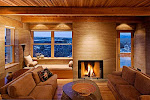Architecture is the crucible of HDR programs. The hard edges between light and dark areas generate halos etc. Up to this point I ALMOST ALWAYS found it better to light the site artificially rather than try and make an HDR image look decent. Don't think I didn't try. I own or have tried most if not all the HDR programs out there and largely given up in frustration.
Then came Lightroom 3 and the Enfuse Plugin. I have much testing to do, but my initial tests show great potential. The test below (bottom) is the DEFAULT settings from a 2 stop exposure bracket, straight from the DNGs in LR3. The image on the top is the unaltered "middle" exposure. Hmmmm........
Architecture by Dekker Perich Sabatini-Albuquerque, Las Vegas and Amarillo. The University of Nevada Reno Center for Molecular Medicine in Reno Nevada.
Now you might say that this could be done by boosting the Recovery and Fill Light sliders and.......yes you could and I did, but you concurrently generate pattern noise in the shadows you boost. Enfuse's method of sampling the shadows from the brightest exposure creates bright shadows with zero noise (this is typical of all the HDR programs I have tested).
This HDR'd result tries to more closely mimic the eyes experience of the scene where the eye dilates as it moves from shadowed areas to the windows. If you overdue it, bringing the window light down further, the lack of brightness in the windows seems unnatural resulting in that overdone HDR effect.
Subscribe to:
Post Comments (Atom)















WOW! I'm totally impressed.
ReplyDeleteYou said DNGs - does it require conversion to DNG, or do you do that routinely when you import your raw files? I have been keeping my files in native raw so I can use DXO for lens specific corrections - although that might be less of an issue with Lightroom 3.
ReplyDeleteEd, With commercial files, I routinely convert on import to DNGs with the Raw File embedded. I think with LR/Enfuse thought you could work from supported RAWs, DNGs, TIFFs or whatever. I am always looking for plugins that will work from RAWs or DNGs for simplicity's sake-like doing panorama merges from RAWs in Bridge. It simplifies the workflow.
ReplyDeleteThanks Kirk! I took a look at Enfuse and it looks like it will use whatever you have that Lightroom uses. It looks like a terrific plugin for a great price - whatever you think is fair as donateware. I am going to give it a try soon.
ReplyDeleteI've used EnfuseGUI with good results. Right now I'm really impressed with Oloneo Photoengine. It's super fast and allows useful tweaks that none of the other tonemappers offer.
ReplyDeleteBy the way Kirk, your image is beautifully composed. It would be great to hear more from you on the subject of composition.
I am very interested in what someone such as you has to say on this subject.
ReplyDeleteStrictly speaking, at least in the original sense of the term, Enfuse is not HDRI in that it does not involve tonemapping and uses a very different process for combining the component images than "true" HDR/tonemapping. I am used to referring to Enfuse as exposure "blending," and it is my understanding that it is a kind of auto-compositing process. Photomatix, one of the main true HDR software programs, now offers an option for a process that works very similarly to Enfuse, and there is a Lightroom 3 Photomatix plug in for this.
In my experience, the Enfuse process is not as good as true HDR for bridging very high contrast ranges. On the other hand, it is less prone to the kind of unpleasant artifacts that can sometimes limit the usefulness of HDR/tonemapping for architectural work.
One nice benefit of exposure blending (exposure fusion as the Photomatix version is called), is that it tends to reduce noise considerably, whereas HDR tonemapping tends to increase noise, sometimes in very weird and unpleasant ways.
I notice your initial test here uses a rather modest bracketed range of 2 stops. In my experience, with a subject such as this, and a greater contrast range requiring more exposures over a wider range, the brighter exposures will start to exhibit sensor bloom, which will show up in the final composite image.